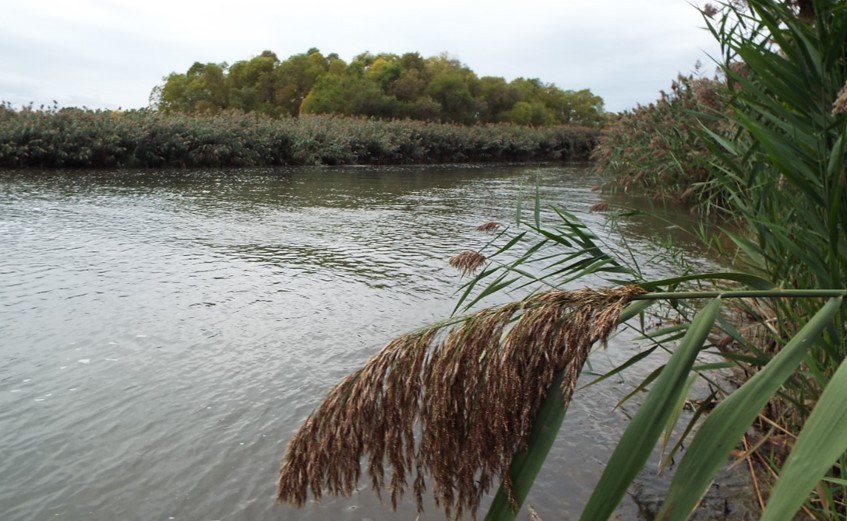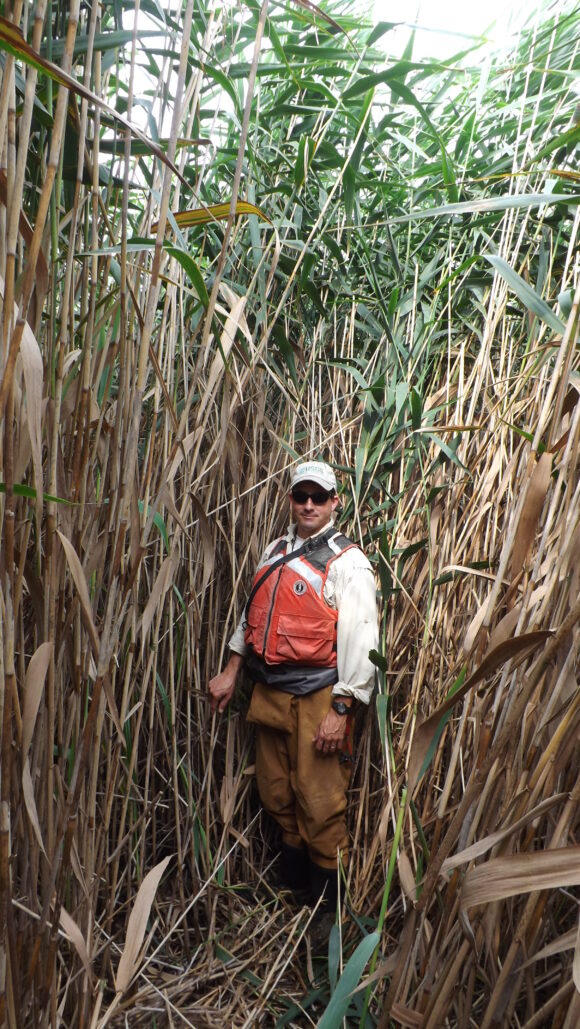
The large size and rapid growth of non-native Phragmites australis (common reed) help it outcompete native plants and take over coastal wetlands in western Lake Erie (Photo credit: USGS)
Invasive plant species are typically fast growing. Highly competitive with native plants, they are ecosystem disruptors, often displacing native plant as well as animal species.
A research team led by James White, professor in the Department of Plant Biology at Rutgers University, and Kurt Kowalski, a wetland ecologist and research scientist at the U.S. Geological Survey, Great Lakes Science Center, Ann Arbor, Michigan, has been collaborating for nearly a decade to create new herbicides that are free of toxic components and control invasive plants without causing harm to people or the environment.
“Conventional herbicides are a concern for some, especially when used in natural settings where native plant and animal health is a priority. Questions exist about how conventional herbicides degrade in the environment and what the risks are to non-target species and human health,” Kowalski explains.
“Our goal is to develop an herbicide composed of naturally occurring and readily biodegradable components, what we are calling a ‘bioherbicide,’ so we can reduce or potentially eliminate some of these negative impacts on the environment and human health while still having the desired negative effect on invasive plants,” he adds.

Research wetland ecologist stands in front of a tall patch of invasive Phragmites australis (common reed) in a Great Lakes coastal wetland. (Photo credit: USGS)
Kowalski and White’s strategy has been to alter the plant microbiome to reduce competitiveness and induce death of the invasive plants. Each spring and summer, they test their experimental herbicides on the abundant invasive, common reed (Phragmites australis), through field trials in New Jersey and Michigan.
“We wanted to control weedy and invasive plants by negatively affecting the plants microbiome using herbicide ingredients that were totally non-toxic, an idea that Kurt first came up with,” says White.
Weedy and invasive plants are filled with microbes (bacteria and fungi) through which they acquire their nutrients. “Our initial strategy was to truncate the symbiosis between the bacteria and plants to reduce the benefits of the microbes to plants,” he adds.
This approach had limited success as it was not effective enough “to deal a death blow to our invasive Phragmites plants, which grows so vigorously that it can reach heights of 15 feet.”
White and Kowalski decided that a different approach was needed and over several months during the height of the COVID-19 pandemic, they met virtually to devise a new strategy.
“I call this a ‘pathodelic strategy’ [meaning pathogenicity manifesting] where the goal was to treat plants with nutrients that converted the normally beneficial microbes in plants into pathogens that cause stress in plants, leading to their death,” White explains.
“To the best of our knowledge, this focus on controlling invasive plants via application of non-toxic chemicals to alter the relationship between plants and their microbiome has not been widely tested,” Kowalski adds.
The research teams are using what they’ve learned about the interaction between plants and their symbiotic microbial counterparts to test and refine different formulations of non-toxic components that can change the relationship between plants and microbes from a beneficial to a negative one.
“Essentially, we are working to turn the microbes against the plants to reduce their competitive advantage, increase physiological stress and ultimately induce death and decomposition that allows native species to return,” says Kowalski.
According to White, “we don’t know if we will end up producing a new commercial herbicide, but the approach we are using is novel using exclusively non-toxic ingredients, basically edible components, to force the plant’s microbiome to kill the plant. We want to show that herbicides do not need to be composed of toxic chemicals. Use of toxins in herbicides has been the predominant practice for decades.”
Research at the USGS Great Lakes Science Center has strongly focused on finding new more effective ways to manage invasive species and increase the quality and quantity of desirable habitat for native plants and wildlife.
“Collaborating with the Rutgers team, we now know that bacteria enter into plant cells to provide nutrients to those cells and stimulate their growth. This understanding is what led us to our current work exploring strategies that target the plant-microbe relationship to control the growing problem of invasive plants and offer more tools in the resource manager toolbox,” says Kowalski.
White is optimistic about their new research focus.
“We are still trying to perfect our experimental herbicide, but what we are seeing in field experiments is promising. Invasive Phragmites is among the most difficult plants to control, but we are encouraged by the results so far. However, we still have a lot to do before we have a product that can be used on a large scale. Ultimately, we also would love to see a similar bioherbicide used in agriculture to provide another option to farmers and homeowners.”
Rutgers and the U.S. Geological Survey have already developed a couple of patents related to maturing novel herbicide technologies and continue their research, primarily with investments by the Great Lakes Restoration Initiative, a Congressionally-funded multi-agency collaboration to target the biggest threats to the Great Lakes ecosystem.

